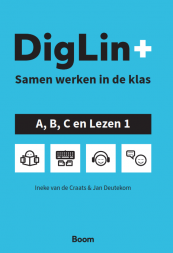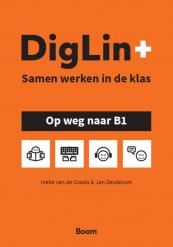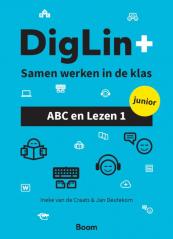About the authors of DigLin+
For years, Jan has been a teacher and founder of FC-Sprint², an educational approach developed at Friesland College, designed to increase educational efficiency. The method focuses on a fundamentally different approach, especially regarding the behavior of teachers towards students. Learning in a different, challenging way with resources as a basis.
Ineke was a teacher for many years and worked at the Department of Linguistics at Radboud University Nijmegen. She has had a multifaceted career in the field of NT2. Although she is now retired, she is not sitting still. In recent years, she has developed the digital literacy method DigLin+ based on previous projects, together with Jan Deutekom. We spoke to her about literacy and digital learning.
'My first introduction to NT2 was in the 1980s, when I taught Dutch to guest workers. We did that at the carpentry table of the community center, using primitive materials. In the evenings I taught highly educated Italian ladies. There was no greater contrast, but I loved it.
My interest in literacy came when I started the magazine Alphanews with a colleague. Through that we came into contact with Jan Deutekom, who was working on didactics and technology at Friesland College. We turned out to complement each other well, so we started working together. That was the beginning of DigLin+. Jan had made templates with which you could practice with words and sounds. I loved that because it allowed you to make things visual. Sound-sign pairing was suddenly depicted as you dragged blocks of letters to the correct sound by yourself while having a picture and sound to help you. I thought that was a brilliant move.
He said, “DigLin is my teacher." That was exactly the point.
At first, I wondered: how do you get students to work independently so early on? Instruction is always difficult, so how do you solve that? In DigLin+ we solved it by giving no instruction. And that turned out to work. I once spoke to a student from Afghanistan. Completely illiterate, but very handy with computers. He said, “DigLin is my teacher. This teacher always listens and I never have to wait my turn." Yes,
that was exactly the point.
The idea of DigLin+ is that you give more material than what the exercise is about. You then see that students start doing extra things of their own accord, for example pronouncing a word in a bingo exercise. You also see that they develop strategies to speed up.
Students start doing extra things by themselves, such as saying a word during a bingo exercise.
As an instructor, you have to lead your students to speed and error-freeness. You used to be done if you did a fill-in-the-blank exercise once, but we say: you've stroked it once, but you're not done until you can do it in two minutes without errors. Teachers figure out for themselves how to use DigLin+, we don't prescribe it. The important thing is that a student achieves a level, whether that is with 40 or 100 exercises. I know a teacher who hangs tasks on the wall, and students watch what they pick up. And with the evaluation form, students keep track of their own progress. It works: it motivates enormously and regularly leads to cheers.
We now have a Facebook group where a lot of teachers talk about DigLin+ and share their suggestions and experiences. We love the fact that teachers are so involved. A community has been created.



